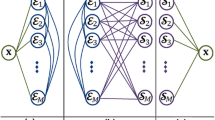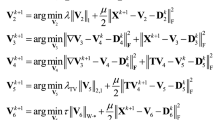Abstract
Spectral unmixing estimates the abundance of each endmember at every pixel of a hyperspectral image. Each material in traditional unmixing algorithms is represented through a constant spectral signature. However, endmember variability always exists due to environmental, atmospheric, and temporal conditions, which leads to poor accuracy of the estimated abundances. This paper proposes a new unmixing algorithm based on a new linear transformation called endmember orthonormal mapping (EOM) to overcome the aforementioned problem. The EOM transformation maps original spectral space to a new EOM space to reduce endmember variability. In the original spectral space, each material is represented by a set of spectra (endmember set) which is extracted using the automated endmember bundles (AEB) method. The EOM transforms each endmember set to a vector in the EOM space so that these vectors are orthonormal. On account of orthonormalized endmembers, the condition number of the mixing matrix in the EOM space reduces. Furthermore, we consider the noise term as an additional virtual endmember set mapped to a vector that is orthogonal to other endmembers. As a result, a promising unmixing accuracy is obtained through applying the least squares abundance estimation in the subspace orthogonal to noise. Experimental results of both synthetic and real hyperspectral images demonstrate that the proposed algorithms provide much enhanced performance compared with the state-of-the-art algorithms.














Similar content being viewed by others
References
Acito N, Diani M, Corsini G (2011) Signal-Dependent Noise Modeling and Model Parameter Estimation in Hyperspectral Images. IEEE Trans Geosci Remote Sens 49:2957–2971
Antia HM (2002) Numerical methods for scientists and engineers. Volume 1, Springer Science & Business Media
Bateson CA, Asner GP, Wessman CA (2000) Endmember Bundles: A New Approach to Incorporating Endmember Variability into Spectral Mixture Analysis. IEEE Trans Geosci Remote Sens 38(2):1083
Bioucas-Dias JM, Plaza A, Dobigeon N, Parente M, Du Q, Gader P, Chanussot J (2012) Hyperspectral unmixing overview: geometrical, statistical, and sparse regression-based approaches. IEEE J Select Top Appl Earth Obs Remote Sens (JSTARS) 5(2):354–379
Chang C (2000) An information-theoretic approach to spectral variability, similarity, and discrimination for hyperspectral image analysis. IEEE Trans Inf Theory 46:1927–1932. doi:10.1109/18.857802
Chang C, Ji B (2006) Weighted Abundance-Constrained Linear Spectral Mixture Analysis. IEEE Trans Geosci Remote Sens 44:378–388
Chang C, Wu C, Liu W, Ouyang Y (2006) A new growing method for simplex-based endmember extraction algorithm. IEEE Trans Geosci Remote Sens 44(10)
Cho MA, Debba P, Mathieu R, Van Aardt J, Asner G, Naidoo L, Main R, Ramoelo A, Majeke B (2009) Spectral variability within species and its effects on Savanna tree species discrimination. Geoscience Remote Sensing Symp (IGARSS), IEEE Int 2:II-190–II-193. doi:10.1109/IGARSS.2009.5418038
Du X, Zare A, Gader P, Dranishnikov D (2014) Spatial and Spectral Unmixing Using the Beta Compositional Model. IEEE J Select Top Appl Earth Obs Remote Sens (JSTARS) 7(6):1994–2003
Ebadi L, Shafri HZM (2014) A stable and accurate wavelet-based method for noise reduction from hyperspectral vegetation spectrum. Earth Sci Informatics
Erer I, Kent S, Kartal M, Kargin S (2004) Superresolution bistatic spotlight sar imaging using image fusion. Proceedings of E USAR, 787–790
Gao BC (1993) An operational method for estimating signal to noise ratios from data acquired with imaging spectrometers. Remote Sens Environ 43(1):23–33
Gao L, Du Q, Zhang B, Yang W, Wu Y (2013) A Comparative Study on Linear Regression-Based Noise Estimation for Hyperspectral Imagery. IEEE J Selected Topics Appl Earth Observations Remote Sensing 6:488–498
Heinz DC, Chang C (2001) Fully constrained least squares linear spectral mixture analysis method for material quantification in hyperspectral imagery. IEEE Trans Geosci Remote Sens 39:529–545. doi:10.1109/36.911111
Iordache MD, Bioucas-Dias JM, Plaza A, Somers B (2014) MUSIC-CSR: Hyperspectral unmixing via multiple signal classification and collaborative sparse regression. Geoscience Remote Sensing, IEEE Trans 52(7):4364–4382
Jin B, Wang B, Zhang L (2010) A Novel Approach Based on Fisher Discriminant Null Space for Decomposition of Mixed Pixels in Hyperspectral Imagery. IEEE Geosci Remote Sens Lett 7:699–703. doi:10.1109/LGRS.2010.2046134
Keshava N, Mustard JF (2002) Spectral unmixing. IEEE Signal Process Mag 19:44–57. doi:10.1109/79.974727
Liu X, Xia W, Wang B, Zhang L (2011) An approach based on constrained nonnegative matrix factorization to unmix hyperspectral data. Geoscience Remote Sensing, IEEE Trans 49(2):757–772
Manolakis D, Siracusa C, Shaw G (2001) Hyperspectral subpixel target detection using the linear mixing model. IEEE Trans Geosci Remote Sens 39:1392–1409. doi:10.1109/36.934072
Mei S, He M, Wang Z, Feng D (2010) Spatial Purity Based Endmember Extraction for Spectral Mixture Analysis. IEEE Trans Geosci Remote Sens 48(9):3434–3445
Miao L, Qi H, Szu H (2007) A maximum entropy approach to unsupervised mixed-pixel decomposition. Image Proc, IEEE Trans 16(4):1008–1021
Nascimento JMP, Bioucas-Dias JM (2005) Does independent component analysis play a role in unmixing hyperspectral data? IEEE Trans Geosci Remote Sens 43:175–187. doi:10.1109/TGRS.2004.839806
Pu H, Chen Z, Wang B, Xia W (2015) Constrained Least Squares Algorithms for Nonlinear Unmixing of Hyperspectral Imagery. IEEE Trans Geosci Remote Sens 53:1287–1303
Roberts DA, Gardner M, Church R, Ustin S, Scheer G, Green RO (1998) Mapping chaparral in the santa monica mountains using multiple endmember spectral mixture models. Remote Sens Environ 65:267–279
Somers B, Delalieux S, Stuckens J, Verstraeten WW, Coppin P (2009a) A weighted linear spectral mixture analysis approach to address endmember variability in agricultural production systems. Int J Remote Sens 30:139–147
Somers B, Cools K, Delalieux S, Stuckens J, Van der Zande D, Verstraeten WW, Coppin P (2009b) Nonlinear hyperspectral mixture analysis for tree cover estimates in orchards. Remote Sens Environ 113(6):1183–1193
Somers B, Asner GP, Tits L, Coppin P (2011) Endmember variability in spectral mixture analysis: a review. Remote Sens Environ 115:1603–1616
Somers B, Zortea M, Plaza A, Asner GP (2012) Automated Extraction of Image-Based Endmember Bundles for Improved Spectral Unmixing. IEEE J Selected Topics Appl Earth Observations Remote Sensing 5(2):396–408
Song CH (2005) Spectral mixture analysis for subpixel vegetation fractions in the urban environment: how to incorporate endmember variability? Remote Sens Environ 95:248–263
Sun W, Li W, Li J, Lai YM (2015) Band selection using sparse nonnegative matrix Factorization with the thresholded Earth’s mover distance for hyperspectral imagery classification. Earth Sci Informatics
Tits L, Keersmaecker W, Somers B, Asner GP, Farifteh J, Coppin P (2012) Hyperspectral shape-based unmixing to improve intra- and interclass variability for forest and agro-ecosystem monitoring. ISPRS J Photogram Rem Sens 74:163–174
Vaiphasa C, Skidmore AK, de Boer WF, Vaiphasa T (2007) A hyperspectral band selector for plant species discrimination. ISPRS J Photogram Rem Sens 62(3):225–235
Wedin P-Å (1973) Perturbation theory for pseudo-inverses. BIT 13:217–232
Zare A, Gader P (2010) PCE: piecewise convex endmember detection. IEEE Trans Geosci Remote Sens 48:2620–2632
Zare A, Ho KC (2014) Endmember Variability in Hyperspectral Analysis: Addressing Spectral Variability During Spectral Unmixing. IEEE Signal Process Mag 31:95–104. doi:10.1109/MSP.2013.2279177
Zare A, Gader P, Casella G (2013) Sampling Piecewise Convex Unmixing and Endmember Extraction. IEEE Trans Geosci Remote Sens 51(3):1655–1665
Zhang J, Rivard B, Sanchez-Azofeifa A (2004) Derivative spectral unmixing of hyperspectral data applied to mixtures of lichen and rock. IEEE Trans Geosci Remote Sens 42:1934–1940
Zhuang L, Zhang B, Gao L, Li J, Plaza A (2015) Normal Endmember Spectral Unmixing Method for Hyperspectral Imagery. IEEE J Select Top Appl Earth Obs Remote Sens (JSTARS) 8(6):2598–2606
Acknowledgments
The authors acknowledge Dr. Ben Somers for generously providing the in situ measured data. They also acknowledge the anonymous reviewers for their outstanding comments and suggestions, which greatly helped to improve the technical content and presentation of the manuscript.
Author information
Authors and Affiliations
Corresponding author
Additional information
Communicated by: H. A. Babaie
Rights and permissions
About this article
Cite this article
Jafari, A., Safabakhsh, R. & Ebadzadeh, M.M. Endmember orthonormal mapping in hyperspectral mixture analysis to address endmember variability. Earth Sci Inform 9, 291–307 (2016). https://doi.org/10.1007/s12145-016-0256-4
Received:
Accepted:
Published:
Issue Date:
DOI: https://doi.org/10.1007/s12145-016-0256-4




